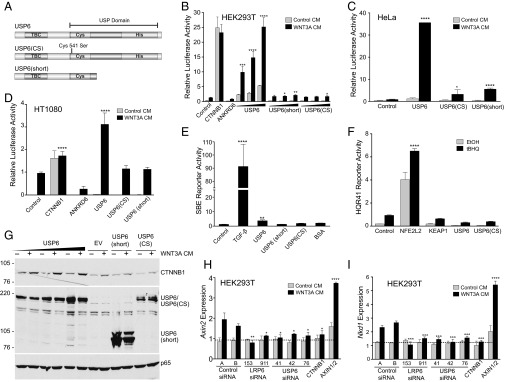Fig. 2.
USP6 activates WNT signaling. (A) Model depicting USP6 alleles. Cysteine (Cys) and histidine (His) subdomains of the USP domain are shown. Ser, serine; TBC, TBC domain. USP6(CS) harbors a point mutation in the cysteine subdomain. (B) Dose-dependent activation of Wnt signaling by USP6. HEK293T cells with an integrated Wnt/β-catenin reporter were transfected with increasing amounts of plasmids encoding USP6 or its variants. Cells were incubated with WNT3A- or control-conditioned media for 16 h before analysis. Data represent mean ± SD (n = 3). (C) USP6 activates Wnt signaling in HeLa cells. HeLa cells were transfected with plasmids expressing USP6 or its variants and Wnt/β-catenin reporter. The cells were incubated with WNT3A- or control-conditioned medium for 24 h before analysis. Data represent mean ± SD (n = 7). (D) USP6 activates Wnt signaling in HT1080 cells. HT1080 cells were transfected with Wnt/β-catenin–firefly luciferase reporter, Renilla luciferase reporter, and the indicated plasmids. Cells were incubated with WNT3A- or control-conditioned media for 12 h before analysis. Data represent mean ± SD (n = 3). (E and F) USP6 does not activate TGF-β or NRF2 signaling. HEK293T cells expressing SBE (TGF-β) reporter or antioxidant response element (hQR41) reporter were transfected with USP6 or its mutants. Tert-butylhydroquinone (tBHQ; 50 μM) and recombinant human TGF-β1 (10 pM) are agonists for the SBE and hQR41 reporters, respectively. Renilla-normalized relative luciferase activity was plotted. Error bars represent mean ± SD (n = 3). (G) USP6 expression stabilizes cytosolic β-catenin. HeLa cells were transfected with plasmids expressing USP6-HA or its mutant isoforms and then incubated overnight with WNT3A- or control-conditioned medium. Cell lysates were analyzed for levels of endogenous β-catenin by immunoblotting. NF-κB p65 subunit was used as a loading control. (H and I) Loss of function of USP6 down-regulates expression of WNT-responsive genes. HEK293T cells were transfected with three independent siRNAs targeting USP6 transcript. Forty-eight hours after siRNA transfection, the cells were treated with control- or WNT3A-conditioned medium. Total RNA was isolated, and expression of Wnt target genes AXIN2 (H) and NKD1 (I) was analyzed by quantitative RT-PCR. Data were normalized to transcript abundance for GAPDH, and represent mean ± SD for biological triplicates.

